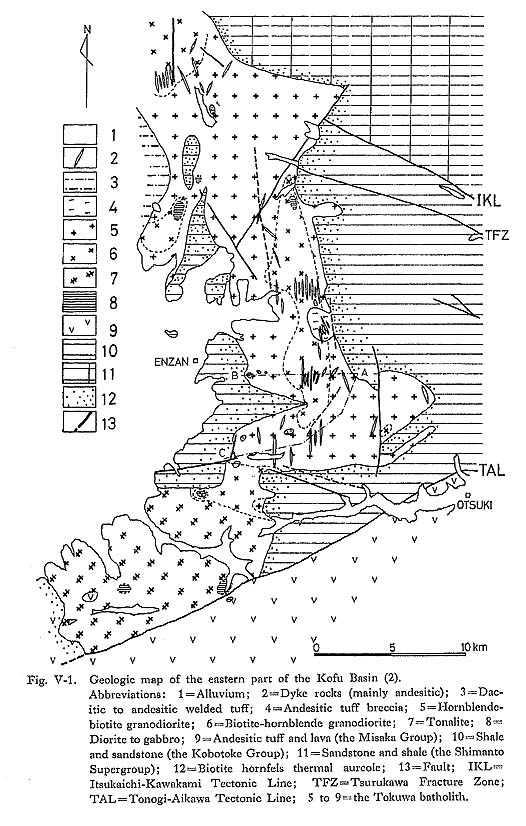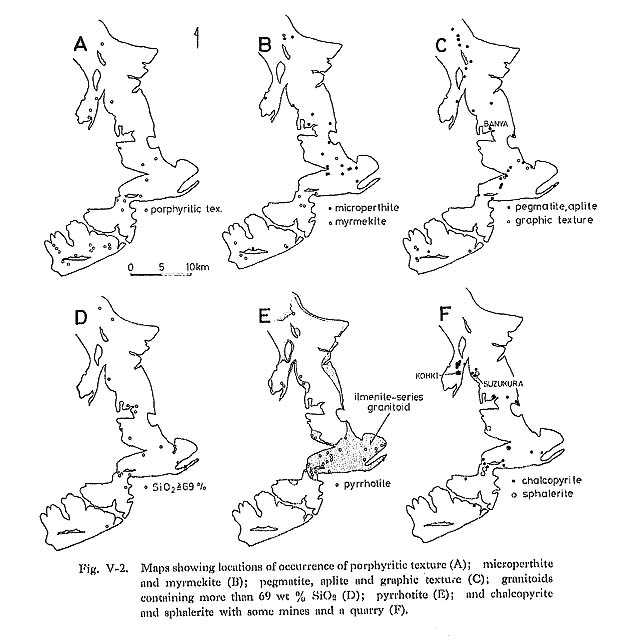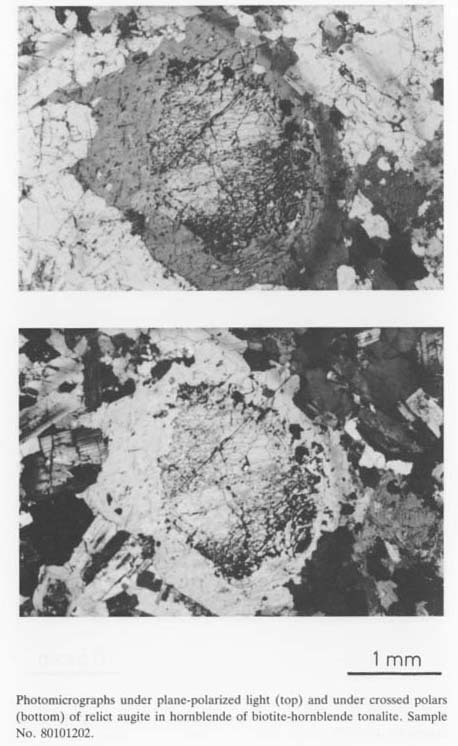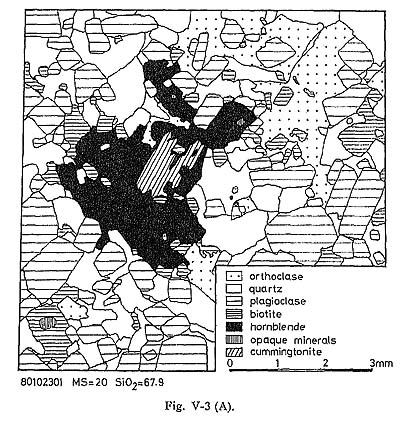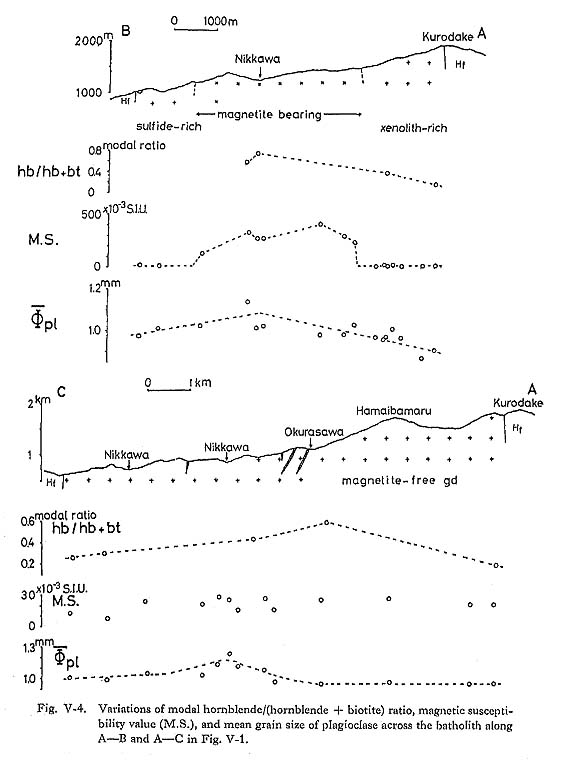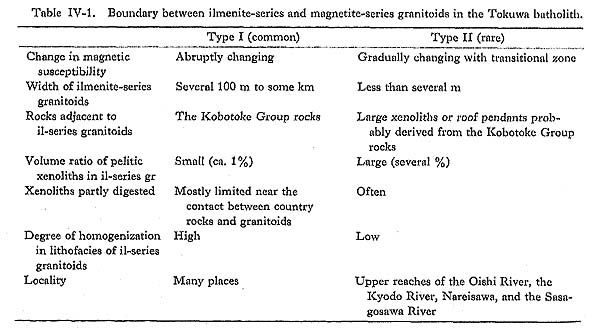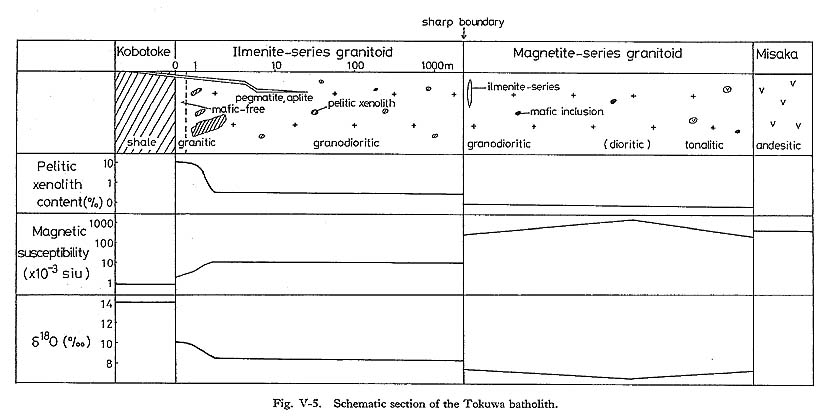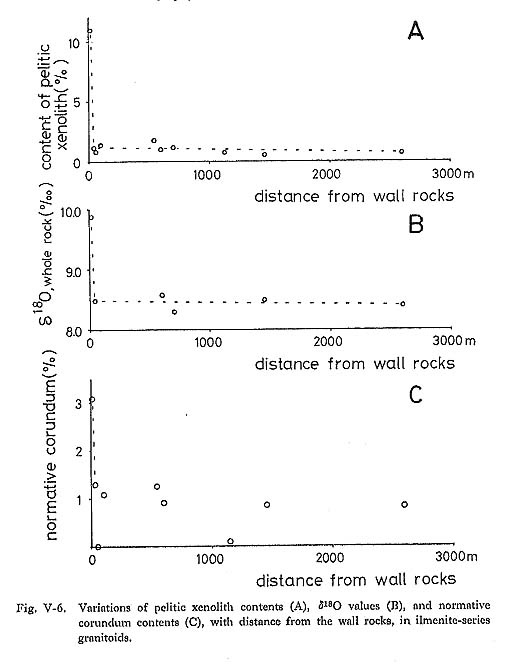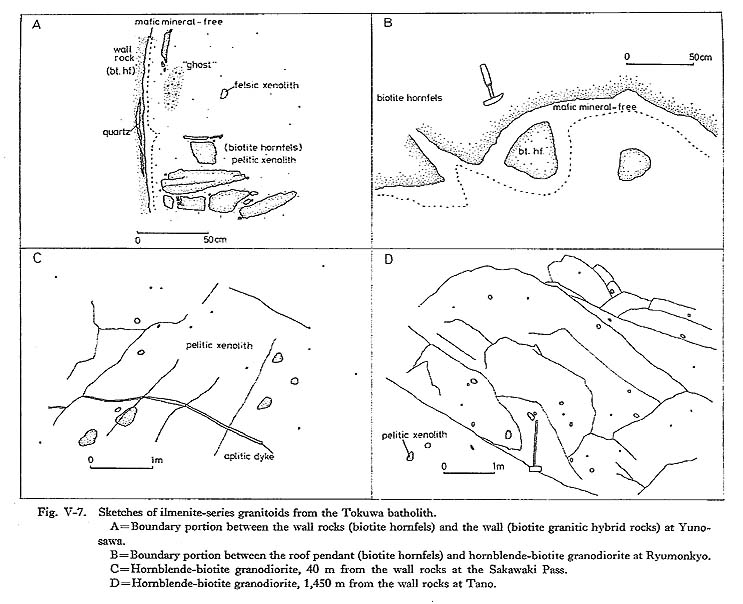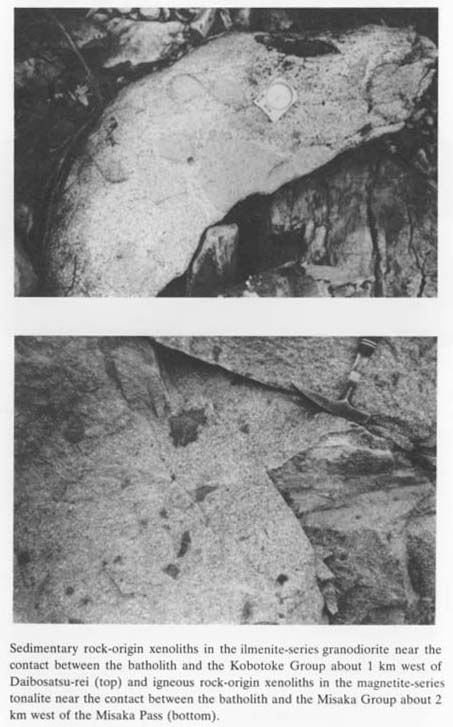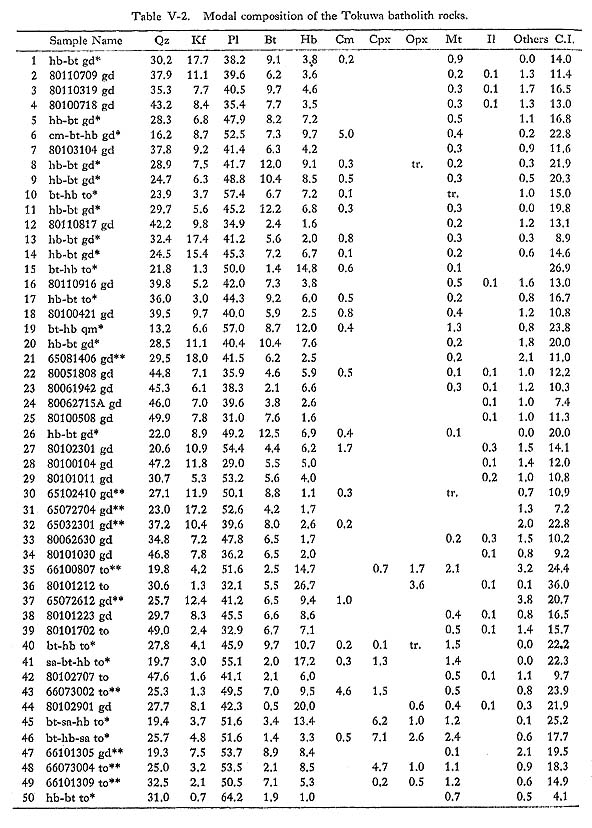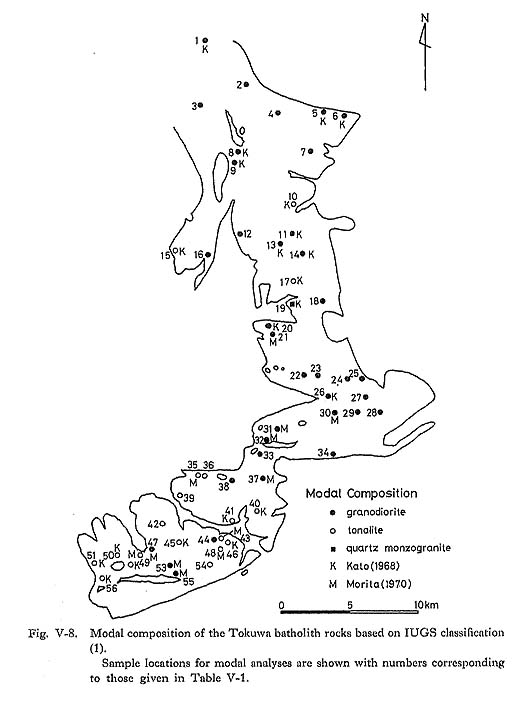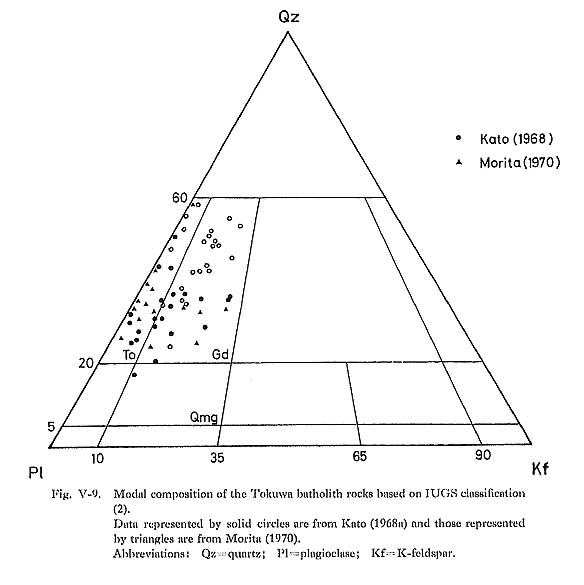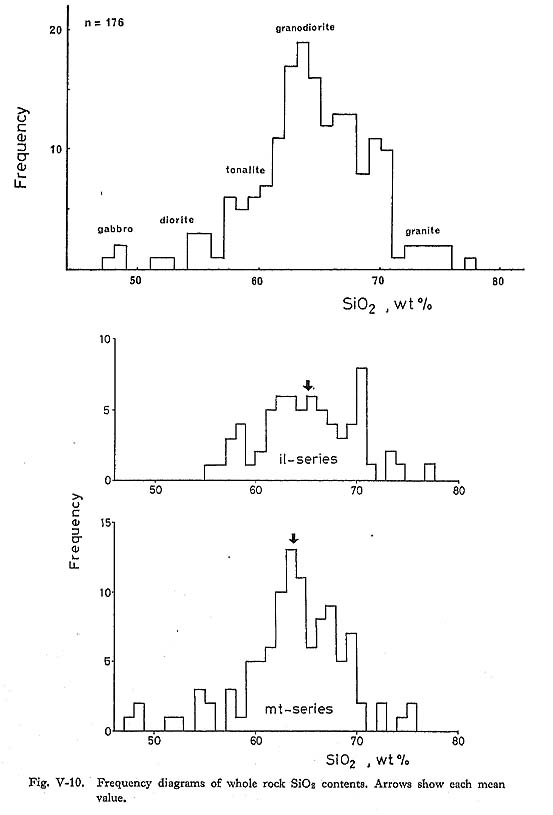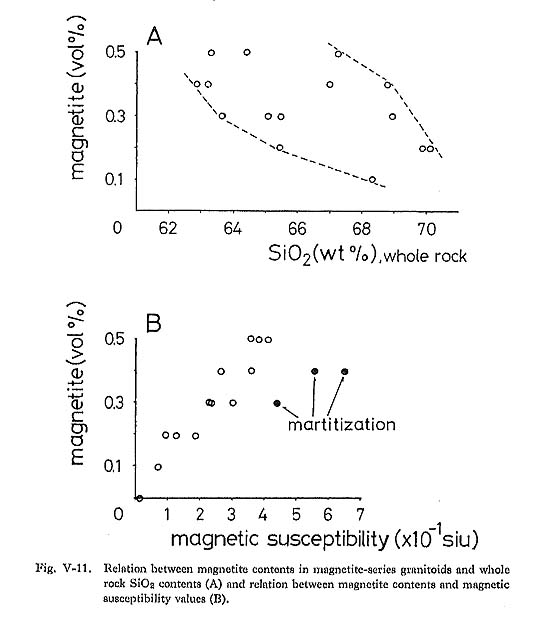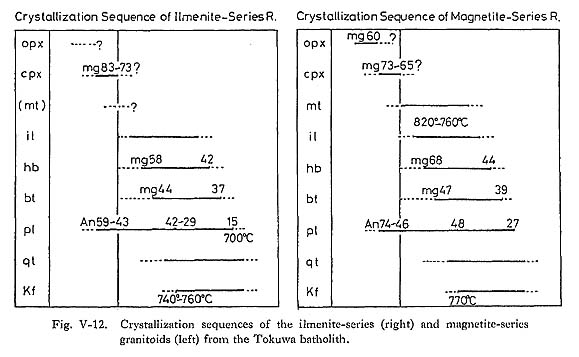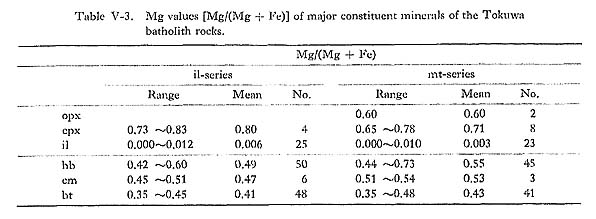CHAPTER V
Petrography of the Tokuwa Batholith Rocks
1) General RemarksThe lithology of the Tokuwa batholith is generally equigranular, medium-grained, non-porphyritic, and unfoliated. Several facies have been distinguished (Fig. V-1): hornblende gabbro and diorite distributed near Kawaura, Jinza-san, Ochiai, and the upper reaches of the Magi River; biotite-hornblende tonalite chiefly in the southern part of the batholith; biotite-hornblende granodiorlte and hornblende-biotite granodiorite in the main. part of the batholith; and biotite granite in some parts along the batholith margin.
Relic augite and/or hypersthene are occasionally observed in the central parts of the batholith, particularly near Kawaura and Jinza-san, while cummingtonite is often observed in the northern and central parts. Porphyritic and micrographic textures (Figs, V-2-A and -B) are rarely recognized in the southern part of the batholith. Local aplitic rocks and pegmatites arc associated with (hornblcnde-)biotitc granodiorite or biotite granite in some parts along the margin of the batholith (Fig. V-2-C). Rocks containing more than 69% SiO2 are limited to areas along the margin of the batholith (Fig. V-2-D). Microscopic observations generally reveal that hornblende and biotite occur as discrete grains in the marginal rocks of the batholith, whereas they occur as aggregates in the central parts. The modal amount of hornblende is greater in the central parts. The marginal rocks of the batholith may possibly be richer in residual liquid than rocks of the batholithic core, or the solidus temperature of the marginal rocks might have been lower than that of batholithic core rocks.
There is no difference in the assemblages of constituent minerals between magnetite-series and ilmenite-scries rocks except for the occurrence of magnetite in the former. The magnetite-series rocks contain a small amount of magnetite, some of which, is marcasitized or martitized and includes ilmenite lamellae or dots. On the other hand, the ilmemte-series rocks contain granular or tabular ilmenite with small amounts of pyrrhotite (Fig. V-2-E) and, rarely, chalcopyrite. Relatively abundant sulfide minerals are contained in granitoids near ore deposits, such as the Suzukura, Hikage, Miroku, and Kohki mines (Fig. V-2-F), and in myarolitic pegmatites such as Banya (Fig. V-2-C and Plate 5). Microscopically they occur as veins cutting through silicate minerals. Most of the sulfide minerals are hence considered to be products of postmagmatic hydrothermal activity.
2) Typical Lithologic CharacterLithologic characters continuously change across the batholith. Typical rock types are described below: Gabbroic to Dioritic Rocks (Central Part)The rocks are dark greenish gray in color, and are medium- to coarse-grained and equigranular. The main constituents are greenish hornblende and plagioclase with small amounts of magnetite, cummingtonite, augite, and rarely hypersthene, biotite, and quartz (Plate 6), However, dioritic rocks at Ochiai contain no magnetite.
Plagioclase is euhedral to subhedral and up to 3 mm in length with normal zoning (core An70 to rim An50; An denotes the anorthite content of plagioclase). Hornblende occurs as a discrete crystal of up to 4 mm in length or as an aggregate of fibrous crystals accompanied by fibrous cummingtonite. It is occasionally contained as poikilitic inclusions in euhedral plagioclase grains. Augite and hypersthene are recognized only in the core parts of horn blende crystals as relict minerals (Plates 7 and 8). Secondary minerals are calcite, chlorite, epidote, and occasionally sulfide minerals such as chalcopyrite and pyrite.
Granodioritic to Tonalitic Rocks (Main Part)The rocks are dark to light gray in color, and are medium-grained and equigranular, Textures of the representative rocks are sketched in Figure V-3. Principal constituent minerals are plagioclase, quartz, biotite, and hornblende with small amounts of orthoclase, apatite (magnetite), ilmenite, and chlorite. Plagioclase (An70-20) is a euhedral crystal with strong zonal structure and albite-twinning. Quartz is generally anhedral and interstitial up to 2.5 mm in diameter. Biotite (mg value; atomic Mg/(Mg+Fe+Mn) ratio=0.30 to 0.40) is a euhedral to subhedral crystal of up to 1.5 mm in diameter with strong pleochroism. It is partly chloritized. Hornblende (mg value; atomic Mg/(Mg+Fe) ratio=0.40 to 0.50) is a subhedral to euhedral crystal of up to 1.5 mm in length. Patches of cummingtonite are occasionally present in hornblende.
(Hornblende-)Biotitr Granodioritic to Biotite (Marginal Part)Light gray, fine- to medium-grained, equigranular, and occasionally somewhat porphyritic rocks occur in some areas along the margin of the batholith. They are composed mainly of plagioclase (An50-20), K-feldspar, quartz, biotite (mg value=0.40 to 0.45), ilmenite, and occasionally hornblende (mg value=0.45 to 0.60). K-feldspar, quartz, and biotite are abundant. These minerals decrease toward the center of the batholith as hornblende increases. Biotite and hornblende occur as discrete crystals, whereas they generally occur as aggregates in the center of the batholith. Figure V-4 shows some petrographic variations along traverses A-B and A-C (A, B, and C are as shown in Fig. V-1). Modal hornblende/(hornblende+biotite) ratios progressively increase toward the center of the batholith. Mean values of plagioclase grain sizes do not change abruptly along traverses A-B and A-C, and this fact indicates that the batholith consists of a single cooling unit.
3) Boundary between Ilmemte-Series and Magnetite-Series RocksLithologic characters generally do not change across the boundary between the two series of granitoids. Exceptional cases are, however, observed. For example, at the Sasagosawa River (Plate 12 and Table IV-1) grayish fine-grained ilmenite-series hornblende biotite granodiorite and light grayish medium-grained magnetite-series granodiorite are in contact with one another forming a band-like structure. Each band varies from several cm to several tens of cm in width. The ilmenite-series bands commonly contain pelitic xeno-liths which are digested to some extent, whereas the magnetite-series bands do not contain them.
Schematic features and the chemistry of the rocks and minerals are shown in Table V-1 and Figures V-5 and -6, some of which will be discussed later in detail.
4) Xenoliths and Mafic InclusionsThe Tokuwa batholith is notable for its high xenolith contents, particularly in the marginal parts. The xenoliths have a wide variety of shape, size, and mineralogical composition, but are generally oriented parallel to the intrusion wall. Two main types are recognized: those probably derived from the rocks of the Kobotoke Group (pelitic to psammitic rocks, and in some rare cases, micritic limestone lenses and bedded chert) (Fig. V-7 and Plates 9 and 10), and those of igneous derivatives (Plate 9). Abundant mafic xenoliths are observed, especially in the southern part of the batholith, probably derived from the Misaka Group rocks.
Pelitic to Psammitic Hornfels XenolithsThese are angular in shape, and vary from several mm to several tens of cm in size. They are purple-brown-colored, and composed mainly of biotite and quartz with small amounts of ilmenite, plagioclase, sphene, zircon, and apatite. Pyroxene, hornblende, and orthoclase occasionally show an arrangement nearly parallel to biotite crystals. Chalco-pyrite, pyrite, and pyrrhotite are occasionally enriched around some of the xenoliths. Their texture is granoblastic and nearly equigranular. Biotite occurs as a subhedral to euhedral crystal of up to 5 mm long and occasionally is poikilitic with minute rounded hornblende inclusions. The pleochroism of this biotite is very similar to that of biotite in ilmenite-series rocks. Biotite flakes often have inclusions of zircon with pleochroic halos around them, Plagioclase is a subhedral crystal about 0.2 mm in length, commonly twinned after the Carlsbad and albite laws. The maximum volume of xenoliths is approximately 10% of the granitoids very near the contact and decreases to zero toward the central parts of the batholith (Fig. V-7). Some of xenoliths retain relicts of sedimentary texture and structure. The granitoids containing these xenoliths are generally ilmenite-series rocks. The ilmenite-series granitoids contain tabular and disc-shaped pelitic xenoliths, approximately parallel to the contact plane between granitoids and country rocks. This may be interpreted as a primary flow produced in magma, as will be stated later. Based on the frequent occurrence of digested xenoliths (Fig. V-7-A and Plate 10), it would be reasonable to assume that a considerable degree of assimilation took place in Tokuwa batholith magma during emplacement. Calcareous and Siliceous Hornfels XenolithsThese xenoliths are occasionally observed in ilmenite-series granitoids. They are compact and commonly exhibit a zonal structure. The core is composed of yellowish brown-colored mosaic aggregates of anhedral, highly poikilitic diopside, anhedral plagioclase, and interstitial quartz. Small amounts of orthoclase, sphene, apatite, chlorite, and calcite are also present. Garnet, axinite, wollastonite, and datolite are rarely present. The margin is a pale greenish color and consists of mosaic quartz, diopside, plagioclase, and hornblende. The original rocks of these xenoliths may be inferred to have been impure limestone based on their chemical compositions. Mafic Xenoliths and InclusionsMafic xcnoliths and inclusions are commonly observed in magnetite-series rocks and occur as fine-grained, dark greenish balls of less than several tens of cm in diameter. They are composed mainly of hornblende, biotite, plagioclase, and quartz with small amounts of magnetite, sphene, ilmenite, chlorite, apatite, and pyrite. Some of them are surrounded by a felsic zone composed of quartz and plagioclase with smaller amounts of pyroxene, partly chloritized biotitc, sphene, cummingtonite, orthoclase, prehnite, and calcite. Plagioclase in mafic inclusions occurs as a lath-shaped crystal of up to 0.4 mm long. Blastpor-phyritic plagioclase occasionally reaches 2 mm in length and shows zonal structure and albite-twinning. Most the mineral characters are nearly the same as those of host rocks. 5) Modal CompositionModal compositions of 56 representative rocks from the Tokuwa batholith including data from Kato (1968a) and Morita (1970) are shown in Table V-2. The sample locations are shown in Fig. V-8. Tonalite is predominant in the southern part of the batholith, however, most of the batholithic rocks consist of hornblende-biotite granodiorite and biotite-hornblende granodiorite.
Figure V-9 gives the modal compositions of plagioclase, quartz, and K-feldspar based on the classification and nomenclature recommended by the Subcommission of the International Union of the Geological Sciences (IUGS) on the Systematics of Igneous Rocks (1973). Most of the Tokuwa batholith rocks are plotted in the areas of granodiorite and tonalite, correlating well with the SiO2 content frequency diagrams of the bulk rocks (Fig. V-10) (whole-rock chemistry of the Tokuwa batholith will be discussed in Chapter VII).
Most of the batholithic rocks contain 40 to 55 modal % plagioclase, 20 to 50 modal % quartz, and less than 12 modal % K-feldspar, biotite, and hornblende. The color index of most of the batholithic rocks is less than 24. The mode of biotite is generally higher than that of hornblende in the northern part of the batholith, whereas that of hornblende is higher than that of biotite in the southern part. K-feldspar is generally more abundant in the northern part of the batholith than in the southern part. These facts indicate that granodiorite predominates in the north and tonalite in the south. The amount of magnetite generally ranges from 0.1 to 0.5 volume % in magnetite-series granitoids, and it appears to decrease with the increase of whole-rock SiO2 content (Fig. V-11-A). Ilmenite-serics granitoids do not contain magnetite. The amount of ilmenite generally ranges from 0.1 to 0.3 volume %. The amount of magnetite has a good positive correlation with values of magnetic susceptibility of rocks (Fig. V-11-B). The three solid circles in Figure V-11-B indicate samples in which magnetite has been intensely martitized. The alteration of magnetite to probably maghemite begins for the most part from the mar gins, cracks, and holes of host magnetite. These three samples also show by sericitization of plagloclase and chloritization or epidotization of biotitc. Two of the samples indicate the depletion of δ18O values (+5.4‰ and+4.9‰) as will be discussed later. It is concluded that the high values of magnetic susceptibility and low contents of magnetite are the results of hydrothermal alterations.
6) Crystallization SequenceFigure V-3 shows the representative textures of the Tokuwa batholith rocks. Some rocks contain relict crystals of clinopyroxene enclosed in hornblende, and biotite crystals in most rocks are clustered around the hornblende, so that the sequence of crystallization of these minerals is clear. Based on the textural study, the general sequence of crystallization of the main constituent minerals of the two series of rocks was inferred to be as shown in Fig. V-12. This sequence is consistent with that proposed by Kato (1968a) and Morita (1970), although they did not pay detailed attention to opaque minerals.
The earliest phases observed in magnetite-series rocks are orthopyroxene with mg values (Mg/(Mg+ Fe)× 100) of about 60, clinopyroxene with mg values of 73 to 65, and plagioclase (An74-46), which decrease in abundance toward the margin of the batholith. Orthopyroxene and clinopyroxene are sometimes observed as relicts in hornblende crystals (Plates 7 and 8). Based on textural observations, some hornblende is considered to have begun to crystallize before biotite through partial or complete replacement of clinopyroxene. The anorthite content of plagioclase (An) in the latest stage is 27. Magnetite and ilmenite are commonly observed in hornblende and biotite crystals as euhedral grains, but not in pyroxenes. Hornblende with mg values of 68 to 58 coexists with plagioclase (An70-60). Hornblende stopped crystallizing at a mg value of 44 and it coexisted with plagioclase (An40-30). Biotite with mg values of 47 to 45 also coexisted with plagioclase (An60-50), and it stopped crystallizing with a mg value of 39, when it coexisted with plagioclase (An40-30). Quartz and K-feldspar filling interstices seem to have crystallized at a later stage. The earliest phases of crystallization sequence of ilmenite-series rocks are represented by clinopyroxene with mg values of 80 to 70 and plagioclase (An59-43). Small amounts of orthopyroxene and magnetite might have been present at this stage, The subsequent crystallization is nearly the same as that of magnetite-series rocks. The anorthite content of plagioclase in the latest stage is 15. Hornblende with mg values of 58 to 55 coexisted with plagioclase (An55-40). It stopped crystallizing at a mg value of 39. Biotite with a mg value of 40 coexisted with plagioclase (An50-40) and that with a mg value of 37 coexisted with plagioclase (An40-30). Quartz and K-feldspar are products of a later stage. The mg values in the mafic minerals in the two series of granitoids are shown in Table V-3. The mg values of the minerals that crystallized after the Fe-Ti oxide minerals are slightly different, probably because Fe was consumed to form the Fe-Ti oxide minerals, especially magnetite in magnetite-series rocks. Hornblende and biotite are generally slightly richer in Mg in magnetite-series granitoids. However, a marked difference is found in minerals that crystallized before the Fe-Ti oxide minerals. The differences in the mg values of clinopyroxene and the An contents of plagioclase in the crystallization sequences of the two series of rocks indicate that the melt composition is slightly but definitely different before the crystallization of the Fe-Ti oxide minerals. This gives an important clue to the formation mechanism of ilmenite-series granitoids from the Tokuwa batholith, and completely differs from that discussed by Ishihara and his colleagues (Czamanske et al., 1981). Field observations confirm that there are different contents of politic xenoliths, probably derived from country rocks, between the two granitoid series. Because the shale of the Kobotoke Group is generally richer in alkali and H2O and poorer in CaO than the granitoids of the Tokuwa batholith (sec Chapter VII), the contribution of the pelitic xenoliths to the ilmenite-series melt would render plagioclase crystallized from the ilmenite-series melt less calcic.
|
